2026届高考英语二轮复习:阅读理解 课件(共45张PPT)
文档属性
| 名称 | 2026届高考英语二轮复习:阅读理解 课件(共45张PPT) |  | |
| 格式 | pptx | ||
| 文件大小 | 17.6MB | ||
| 资源类型 | 教案 | ||
| 版本资源 | 通用版 | ||
| 科目 | 英语 | ||
| 更新时间 | 2025-07-16 17:24:57 | ||
图片预览

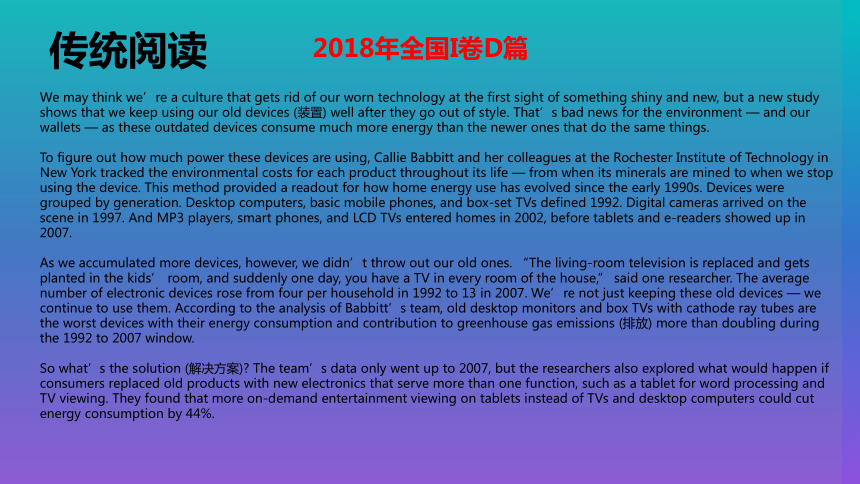
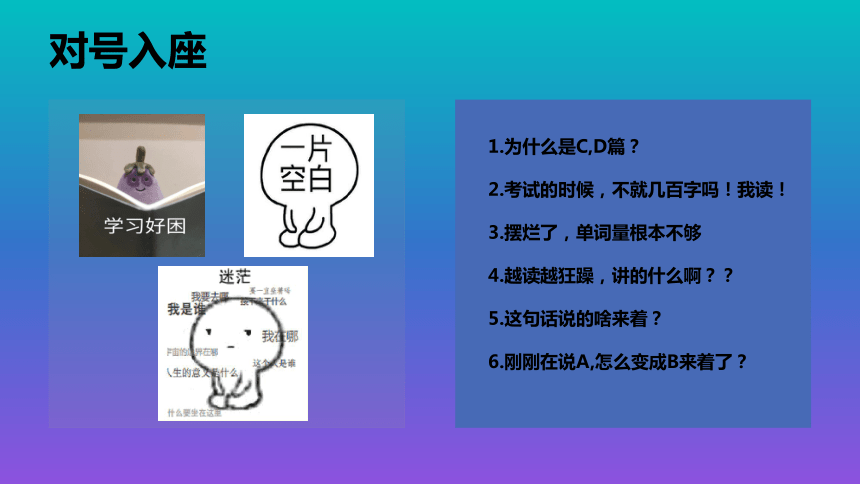
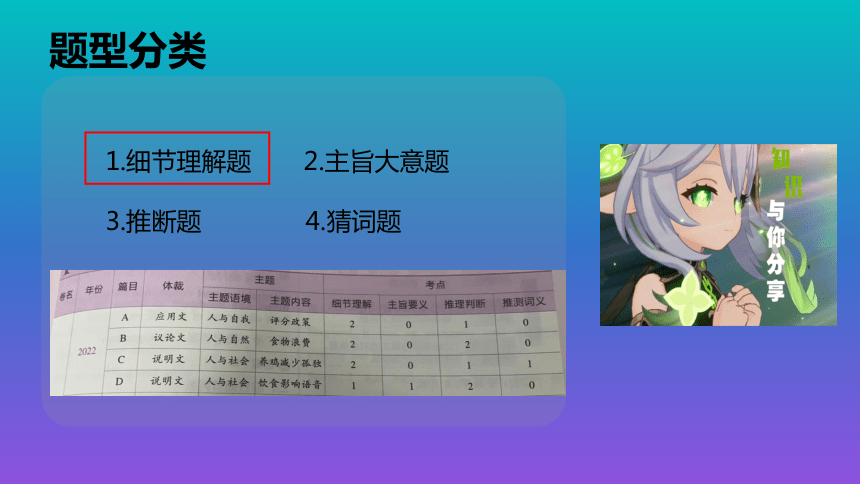
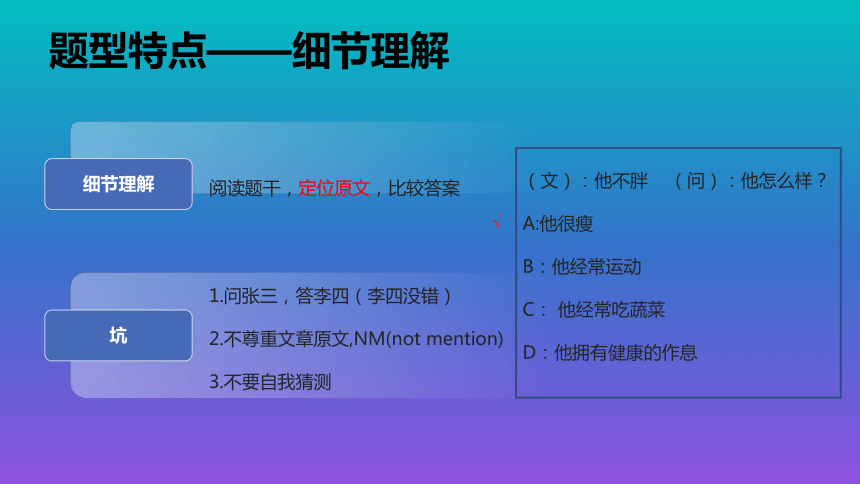
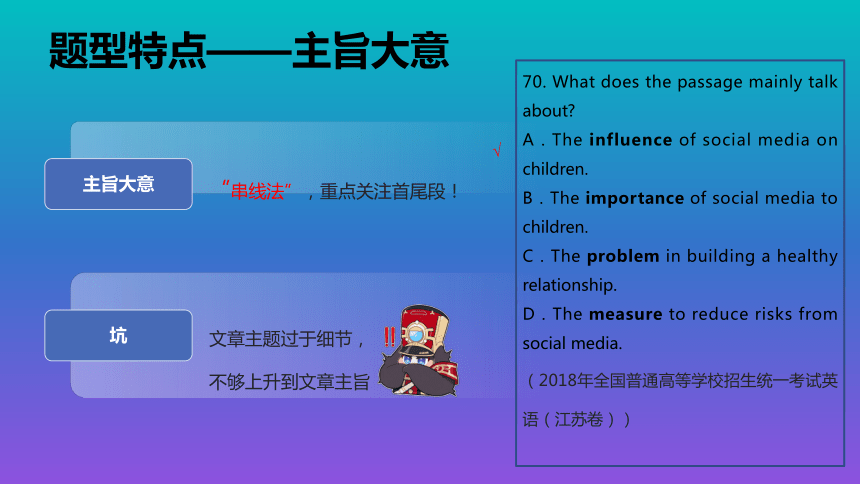
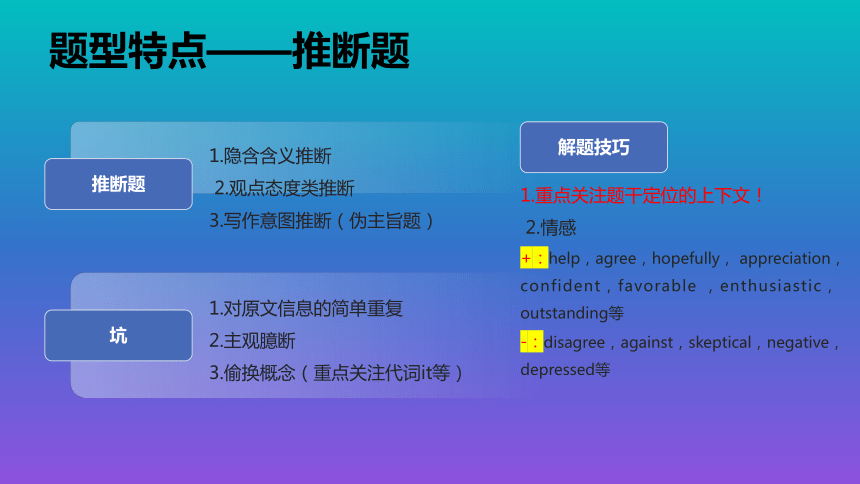
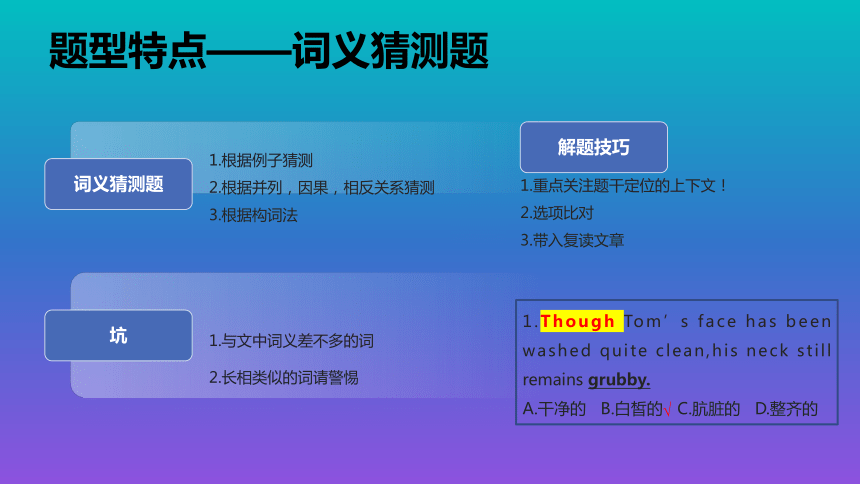
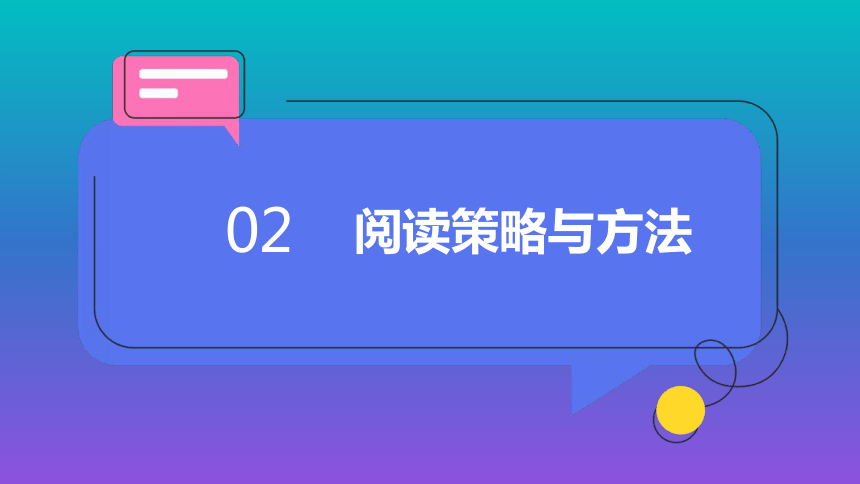
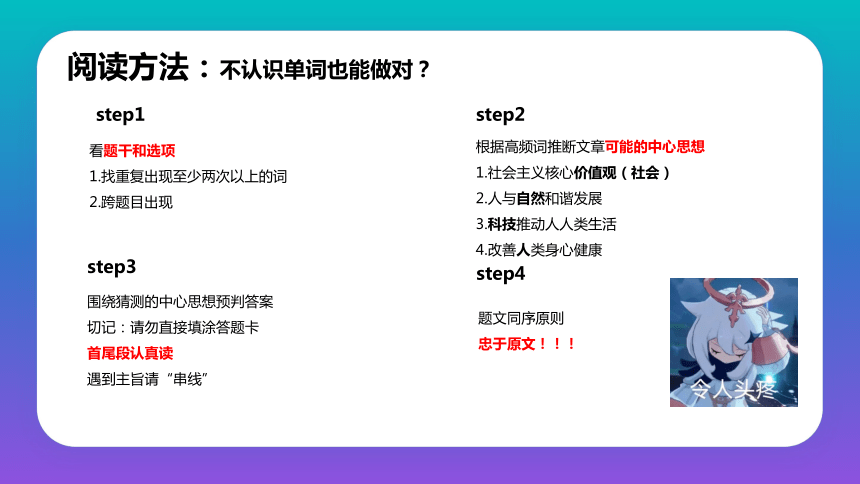
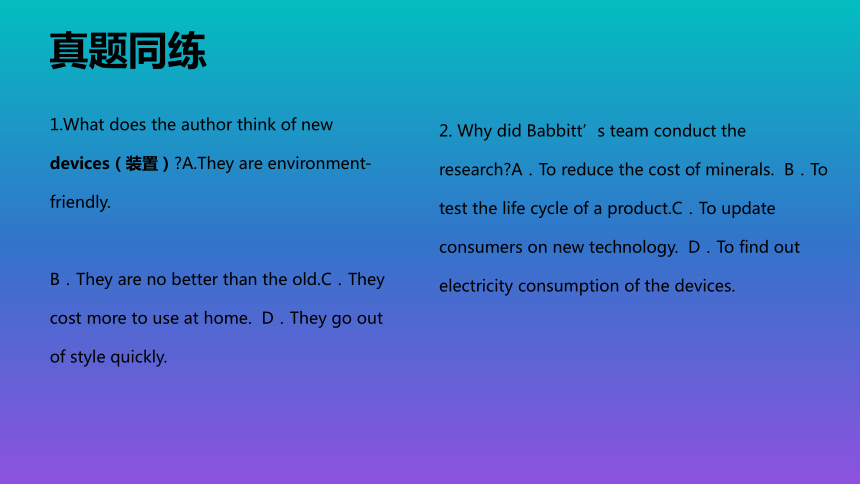
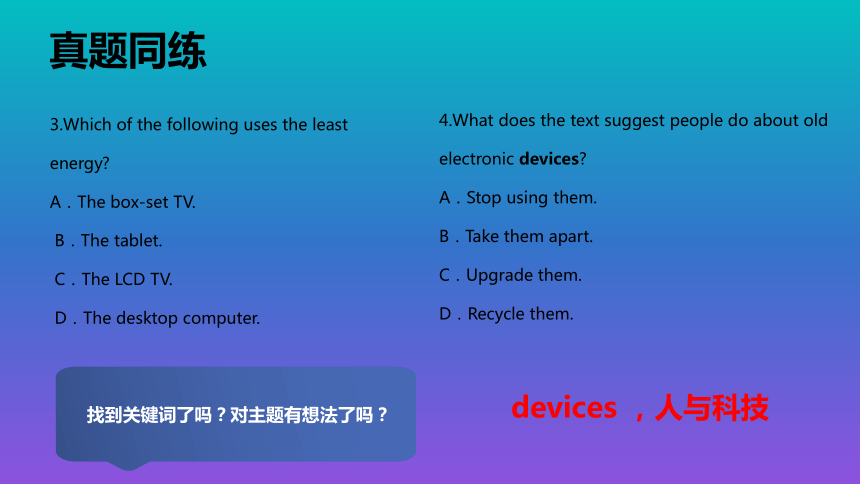
文档简介
(共45张PPT)
阅读理解专项
传统阅读
We may think we’re a culture that gets rid of our worn technology at the first sight of something shiny and new, but a new study shows that we keep using our old devices (装置) well after they go out of style. That’s bad news for the environment — and our wallets — as these outdated devices consume much more energy than the newer ones that do the same things.
To figure out how much power these devices are using, Callie Babbitt and her colleagues at the Rochester Institute of Technology in New York tracked the environmental costs for each product throughout its life — from when its minerals are mined to when we stop using the device. This method provided a readout for how home energy use has evolved since the early 1990s. Devices were grouped by generation. Desktop computers, basic mobile phones, and box-set TVs defined 1992. Digital cameras arrived on the scene in 1997. And MP3 players, smart phones, and LCD TVs entered homes in 2002, before tablets and e-readers showed up in 2007.
As we accumulated more devices, however, we didn’t throw out our old ones. “The living-room television is replaced and gets planted in the kids’ room, and suddenly one day, you have a TV in every room of the house,” said one researcher. The average number of electronic devices rose from four per household in 1992 to 13 in 2007. We’re not just keeping these old devices — we continue to use them. According to the analysis of Babbitt’s team, old desktop monitors and box TVs with cathode ray tubes are the worst devices with their energy consumption and contribution to greenhouse gas emissions (排放) more than doubling during the 1992 to 2007 window.
So what’s the solution (解决方案) The team’s data only went up to 2007, but the researchers also explored what would happen if consumers replaced old products with new electronics that serve more than one function, such as a tablet for word processing and TV viewing. They found that more on-demand entertainment viewing on tablets instead of TVs and desktop computers could cut energy consumption by 44%.
2018年全国I卷D篇
对号入座
1.为什么是C,D篇?
2.考试的时候,不就几百字吗!我读!
3.摆烂了,单词量根本不够
4.越读越狂躁,讲的什么啊??
5.这句话说的啥来着?
6.刚刚在说A,怎么变成B来着了?
题型分类
1.细节理解题 2.主旨大意题
3.推断题 4.猜词题
题型特点——细节理解
细节理解
阅读题干,定位原文,比较答案
坑
1.问张三,答李四(李四没错)
2.不尊重文章原文,NM(not mention)
3.不要自我猜测
(文):他不胖 (问):他怎么样?
A:他很瘦
B:他经常运动
C: 他经常吃蔬菜
D:他拥有健康的作息
√
题型特点——主旨大意
主旨大意
“串线法”,重点关注首尾段!
坑
文章主题过于细节,
不够上升到文章主旨
70. What does the passage mainly talk about
A.The influence of social media on children.
B.The importance of social media to children.
C.The problem in building a healthy relationship.
D.The measure to reduce risks from social media.
(2018年全国普通高等学校招生统一考试英语(江苏卷))
√
题型特点——推断题
推断题
1.隐含含义推断
2.观点态度类推断
3.写作意图推断(伪主旨题)
坑
1.对原文信息的简单重复
2.主观臆断
3.偷换概念(重点关注代词it等)
解题技巧
1.重点关注题干定位的上下文!
2.情感
+:help,agree,hopefully, appreciation,confident,favorable ,enthusiastic,outstanding等
-:disagree,against,skeptical,negative,depressed等
题型特点——词义猜测题
词义猜测题
1.根据例子猜测
2.根据并列,因果,相反关系猜测
3.根据构词法
坑
1.与文中词义差不多的词
2.长相类似的词请警惕
解题技巧
1.重点关注题干定位的上下文!
2.选项比对
3.带入复读文章
1.Though Tom’s face has been washed quite clean,his neck still remains grubby.
A.干净的 B.白皙的 C.肮脏的 D.整齐的
√
阅读策略与方法
02
阅读方法:不认识单词也能做对?
根据高频词推断文章可能的中心思想
1.社会主义核心价值观(社会)
2.人与自然和谐发展
3.科技推动人人类生活
4.改善人类身心健康
step2
看题干和选项
1.找重复出现至少两次以上的词
2.跨题目出现
step1
step3
围绕猜测的中心思想预判答案
切记:请勿直接填涂答题卡
首尾段认真读
遇到主旨请“串线”
题文同序原则
忠于原文!!!
step4
真题同练
1.What does the author think of new devices(装置) A.They are environment-friendly.
B.They are no better than the old.C.They cost more to use at home. D.They go out of style quickly.
2. Why did Babbitt’s team conduct the research A.To reduce the cost of minerals. B.To test the life cycle of a product.C.To update consumers on new technology. D.To find out electricity consumption of the devices.
真题同练
3.Which of the following uses the least energy
A.The box-set TV.
B.The tablet.
C.The LCD TV.
D.The desktop computer.
4.What does the text suggest people do about old electronic devices
A.Stop using them.
B.Take them apart.
C.Upgrade them.
D.Recycle them.
找到关键词了吗?对主题有想法了吗?
devices ,人与科技
略读文章,大致了解重点
1We may think we’re a culture that gets rid of our worn technology at the first sight of something shiny and new, but a new study shows that we keep using our old devices (装置) well after they go out of style. That’s bad news for the environment — and our wallets — as these outdated devices consume much more energy than the newer ones that do the same things. 2To figure out how much power these devices are using, Callie Babbitt and her colleagues at the Rochester Institute of Technology in New York tracked the environmental costs for each product throughout its life — from when its minerals are mined to when we stop using the device. This method provided a readout for how home energy use has evolved since the early 1990s. Devices were grouped by generation — Desktop computers, basic mobile phones, and box-set TVs defined 1992. Digital cameras arrived on the scene in 1997. And MP3 players, smart phones, and LCD TVs entered homes in 2002, before tablets and e-readers showed up in 2007.
略读文章,大致了解重点
3As we accumulated more devices, however, we didn't throw out our old ones. “The living-room television is replaced and gets planted in the kids' room, and suddenly one day, you have a TV in every room of the house,” said one researcher. The average number of electronic devices rose from four per household in 1992 to 13 in 2007. We’re not just keeping these old devices — we continue to use them. According to the analysis of Babbitt’s team, old desktop monitors and box TVs with cathode ray tubes are the worst devices with their energy consumption and contribution to greenhouse gas emissions (排放) more than doubling during the 1992 to 2007 window.
4So what's the solution (解决方案) The team’s data only went up to 2007, but the researchers also explored what would happen if consumers replaced old products with new electronics that serve more than one function, such as a tablet for word processing and TV viewing. They found that more on-demand entertainment viewing on tablets instead of TVs and desktop computers could cut energy consumption by 44%.
你对这篇文章大致有什么理解了?
设备?
环境?
问题?
new/old
解决办法?
1.文章重点关注首尾段
2.每一段段落第一句重点读!
3.连起来即为“串线法’
devices ,人与科技
没有头绪——重读首段(作者观点体现处)
略读文章,大致了解重点
1We may think we’re a culture that gets rid of our worn(旧的) technology at the first sight of something shiny and new, but a new study shows that we keep using our old devices (装置) well after they go out of style. That’s bad (-—)news for the environment — and our wallets — as these outdated devices consume much more energy than the newer ones that do the same things.
1.旧设备过时了,仍在继续用
2.对环境不好
3.旧设备能量消耗过多
读完了!
来做题!
秒杀!
1.What does the author think of new devices(装置) A.They are environment-friendly.
B.They are no better than the old.C.They cost more to use at home.
D.They go out of style quickly.
1.旧设备过时了,仍在继续用
2.对环境不好
3.旧设备能量消耗过多
A.对环境好 +
B.不如旧的 -
C.花更多钱 -
D.过时特快 -
√
感情倾向做题!
秒杀!
2. Why did Babbitt’s team conduct the research
A.To reduce the cost of minerals.
B.To test the life cycle of a product.
C.To update consumers on new technology.
D.To find out electricity consumption of the devices.
1.旧设备过时了,仍在继续用
2.对环境不好
3.旧设备能量消耗过多
A.减少矿物消耗
B.测试产品寿命
C.“更新”消费者新科技
D.找出设备电力消耗
√
1.与原文联系大 2.符合大主题方向
秒杀!
3.Which of the following uses the least energy
A.The box-set TV. B.The tablet.
C.The LCD TV. D.The desktop computer.
1.旧设备过时了,仍在继续用
2.对环境不好
3.旧设备能量消耗过多
A.盒式电视机 B.平板
C.液晶电视 D.台式电脑
√
1.与原文联系大 2.符合大主题方向
秒杀!
4.What does the text suggest people do about old electronic devices
A.Stop using them. B.Take them apart. C.Upgrade them. D.Recycle them.
1.旧设备过时了,仍在继续用
2.对环境不好
3.旧设备能量消耗过多
A.不用了! B.给拆叻!
C.要升级! D.要回收!
√
切忌主观带入!!!
秒杀!
4.What does the text suggest people do about old electronic devices
A.Stop using them. B.Take them apart. C.Upgrade them. D.Recycle them.
1.旧设备过时了,仍在继续用
2.对环境不好
3.旧设备能量消耗过多
A.不用了! B.给拆叻!
C.要升级! D.要回收!
√
切忌主观带入!!!
So what's the solution (解决方案) The team’s data only went up to 2007, but the researchers also explored what would happen if consumers replaced old products with new electronics that serve more than one function, such as a tablet for word processing and TV viewing. They found that more on-demand entertainment viewing on tablets instead of TVs and desktop computers could cut energy consumption by 44%.
这都行?
方法:
1.结构看总分 a new study shows that
2.主角找重复 old devices/outdated devices
3.情感判正负 bad news
Tips:
讲旧的,是为了夸新的,与时俱进
讲过去,1998等为了说现在
数字70%,就是为了举例
xx专家,人名也是为了举例
文章结构总分总
正确选项基本同义替换
相反选项请重点关注
任何技巧都可能出错,但验证不会!
阅读方法!
实战演练
03
2018D篇-1
1Children as young as ten are becoming dependent on social media for their sense of self-worth, a major study warned.
2It found many youngsters(少年)now measure their status by how much public approval they get online, often through “likes”. Some change their behavior in real life to improve their image on the web.
3The report into youngsters aged from 8 to 12 was carried out by Children’s Commissioner (专员)Anne Longfield. She said social media firms were exposing children to major emotional risks, with some youngsters starting secondary school ill-equipped to cope with the tremendous pressure they faced online.
4Some social apps were popular among the children even though they supposedly require users to be at least 13. The youngsters admitted planning trips around potential photo-opportunities and then messaging friends — and friends of friends — to demand “likes” or their online posts.
5The report found that youngsters felt their friendships could be at risk if they did not respond to social media posts quickly, and around the clock.
6Children aged 8 to 10 were “starting to feel happy” when others liked their posts. However, those in the 10 to 12 age group were “concerned with how many people like their posts” , suggesting a “ need” for social recognition that gets stronger the older they become.
7Miss Longfield warned that a generation of children risked growing up “worried about their appearance and image as a result of the unrealistic lifestyles they follow on platforms, and increasingly anxious about switching off due to the constant demands of social media” .
2018D篇-2
8She said: “Children are using social media with family and friends and to play games when they are in primary school. But what starts as fun usage of apps turns into tremendous pressure in real social media interaction at secondary school.”
9As their world expanded, she said, children compared themselves to others online in a way that was “hugely damaging in terms of their self-identity, in terms of their confidence, but also in terms of their ability to develop themselves” .
10Miss Longfield added: “Then there is this push to connect—if you go offline, will you miss something, will you miss out, will you show that you don’t care about those people you are following, all of those come together in a huge way at once.”
11“For children it is very, very difficult to cope with emotionally.” The Children’s Commissioner for England’s study—Life in Likes—found that children as young as 8 were using social media platforms largely for play.
12However, the research—involving eight groups of 32 children aged 8 to 12 — suggested that as they headed toward their teens, they became increasingly anxious online.
2018D篇-3
13By the time they started secondary school—at age 11—children were already far more aware of their image online and felt under huge pressure to ensure their posts were popular, the report found.
14However, they still did not know how to cope with mean-spirited jokes, or the sense of incompetence they might feel if they compared themselves to celebrities(名人)or more brilliant friends online. The report said they also faced pressure to respond to messages at all hours of the day—especially at secondary school when more youngsters have mobile phones.
15The Children’s Commissioner said schools and parents must now do more to prepare children for the emotional minefield(雷区)they faced online. And she said social media companies must also “ take more responsibility” . They should either monitor their websites better so that children do not sign up too early, or they should adjust their websites to the needs of younger users.
16Javed Khan, of children’s charity Barnardo’s, said: “ It’s vital that new compulsory age-appropriate relationship and sex education lessons in England should help equip children to deal with the growing demands of social media.
17“ It’s also hugely important for parents to know which apps their children are using.”
真题练习
1. Why did some secondary school students feel too much pressure
A.They were not provided with adequate equipment.
B.They were not well prepared for emotional risks.
C.They were required to give quick responses.
D.They were prevented from using mobile phones.
2. Some social app companies were to blame because_________
A.they didn’t adequately check their users’ registration
B.they organized photo trips to attract more youngsters
C.they encouraged youngsters to post more photos
D.they didn’t stop youngsters from staying up late
真题练习
3. Children’s comparing themselves to others online may lead to_________.
A.less friendliness to each other
B.lower self-identity and confidence
C.an increase in online cheating
D.a stronger desire to stay online
4. According to Life in Likes, as children grew, they became more anxious to_________.
A.circulate their posts quickly
B.know the qualities of their posts
C.use mobile phones for play
D.get more public approval
真题练习
5. What should parents do to solve the problem
A.Communicate more with secondary schools.
B.Urge media companies to create safer apps.
C.Keep track of children’s use of social media.
D.Forbid their children from visiting the web.
6. What does the passage mainly talk about
A.The influence of social media on children.
B.The importance of social media to children.
C.The problem in building a healthy relationship.
D.The measure to reduce risks from social media.
通过题干和题目得出的关键词1.children/youngers
2.social media/social app
细读首尾段!+简单串线
①Children (as young as ten )are becoming dependent on social media for their sense of self-worth, a major study warned.- 感情倾向负
②It found many youngsters(少年)now measure their status身份 by how much public approval they get online, often through “likes”. Some change their behavior in real life to improve their image形象 on the web.
尾段:“ It’s also hugely important for parents to know which apps their children are using.”
1.孩子们依赖于社交媒体
2.自我价值感
3.文章研究是为了警告
读完了!
来做题!
秒杀!
1.Why did some secondary school students feel too much pressure -
A.They were not provided with adequate equipment.
B.They were not well prepared for emotional risks.
C.They were required to give quick responses.
D.They were prevented from被阻止 using mobile phones.
√
1.孩子们依赖于社交媒体
2.自我价值感
3.文章研究是为了警告
细节题
定位到para3
B选项与原文吻合度高
B选项进行同义替换,大概率预判
D选项迷惑选项,直接与文章主题不符合
同义替换极有可能是正确选项!
秒杀!
2. Some social app companies were to blame-负感情倾向 because ________.
A.they didn't -adequately check their users' registration
B.they organized+ photo trips to attract more youngsters
C.they encouraged +youngsters to post more photos
D.they didn't stop-youngsters from staying up late
√
1.孩子们依赖于社交媒体
2.自我价值感
3.文章研究是为了警告
推理判断
B,C相近选项 A,D选项也相近
一排排俩
看题干感情倾向为负面
锁定A,D
再去定位原文para4
A对原文改写
利用感情倾向进行排除!
秒杀!
3. Children's comparing themselves to others online may lead to ________.
A.less friendliness to each other
B.lower self-identity and confidence
C.an increase in online cheating
D.a stronger desire to stay online
√
1.孩子们依赖于社交媒体
2.自我价值感
3.文章研究是为了警告
细节题
定位到para9
只有B符合我们所概括的文章主旨
A.对别人不友好
B.降低自我认同感和自信心
C.在线作弊
D.网瘾少年
小细节服从大主旨!
秒杀!
4.According to Life in Likes, as children grew, they became more anxious (渴望的 )to_________.
A.circulate their posts quickly
B.know the qualities of their posts
C.use mobile phones for play
D.get more public approval
√
1.孩子们依赖于社交媒体
2.自我价值感
3.文章研究是为了警告
推理判断题
定位到para12
只有D符合我们所概括的文章主旨
再次考察小细节服从大主旨!
A.“朋友圈”刷的飞起
B.了解自己朋友圈的品质
C.用手机来玩耍
D.获得公众认可
小细节服从大主旨!
秒杀!
5. What should parents do to solve the problem
A.Communicate more with secondary schools.
B.Urge media companies to create safer apps.
C.Keep track of children's use of social media.
D.Forbid their children from visiting the web.
√
1.孩子们依赖于社交媒体
2.自我价值感
3.文章研究是为了警告
细节理解题
定位到尾段
请注意问张三别答李四!
太绝对的词大概率不对
A.和学校多沟通
B.要求公司制作更安全的应用
C.了解孩子使用社交媒体的情况
D.禁止孩子上网
关注首尾段!
秒杀!
6. What does the passage mainly talk about
A.The influence of social media on children.
B.The importance of social media to children.
C.The problem in building a healthy relationship.
D.The measure to reduce risks from social media.
√
1.孩子们依赖于社交媒体
2.自我价值感
3.文章研究是为了警告
主旨大意题
符合整体文章感情倾向
犹豫不决就问自己:是不是通篇都在讲A/B/C/D
A.社交媒体的影响 + -
B.社交媒体的重要性 +
C.建立健康关系的问题 /
D.减少社交媒体危害的措施 通篇?对话?
不能太过于细节
总结
04
阅读的初衷?
阅读:获取信息/知识
作文:分享信息/知识
阅读的初衷?——观点接纳
《经济学人》
《卫报》
《时代周刊》
《纽约客》
来源于主流外刊&严肃媒体,逻辑清晰,严谨,总分结构居多
阅读能力培养
考察?
主旨>细节
把握文章整体结构
正确捕捉&理解文章关键信息
此即,智慧之殿堂!
Effort?
1.老师,今天是你在帮我翻译?
2.阅读的方向和重点都不对,背了很多单词,执着于理解细节和次要信息
3.路线正确,你需要做的是跑起来!
The end !
阅读理解专项
传统阅读
We may think we’re a culture that gets rid of our worn technology at the first sight of something shiny and new, but a new study shows that we keep using our old devices (装置) well after they go out of style. That’s bad news for the environment — and our wallets — as these outdated devices consume much more energy than the newer ones that do the same things.
To figure out how much power these devices are using, Callie Babbitt and her colleagues at the Rochester Institute of Technology in New York tracked the environmental costs for each product throughout its life — from when its minerals are mined to when we stop using the device. This method provided a readout for how home energy use has evolved since the early 1990s. Devices were grouped by generation. Desktop computers, basic mobile phones, and box-set TVs defined 1992. Digital cameras arrived on the scene in 1997. And MP3 players, smart phones, and LCD TVs entered homes in 2002, before tablets and e-readers showed up in 2007.
As we accumulated more devices, however, we didn’t throw out our old ones. “The living-room television is replaced and gets planted in the kids’ room, and suddenly one day, you have a TV in every room of the house,” said one researcher. The average number of electronic devices rose from four per household in 1992 to 13 in 2007. We’re not just keeping these old devices — we continue to use them. According to the analysis of Babbitt’s team, old desktop monitors and box TVs with cathode ray tubes are the worst devices with their energy consumption and contribution to greenhouse gas emissions (排放) more than doubling during the 1992 to 2007 window.
So what’s the solution (解决方案) The team’s data only went up to 2007, but the researchers also explored what would happen if consumers replaced old products with new electronics that serve more than one function, such as a tablet for word processing and TV viewing. They found that more on-demand entertainment viewing on tablets instead of TVs and desktop computers could cut energy consumption by 44%.
2018年全国I卷D篇
对号入座
1.为什么是C,D篇?
2.考试的时候,不就几百字吗!我读!
3.摆烂了,单词量根本不够
4.越读越狂躁,讲的什么啊??
5.这句话说的啥来着?
6.刚刚在说A,怎么变成B来着了?
题型分类
1.细节理解题 2.主旨大意题
3.推断题 4.猜词题
题型特点——细节理解
细节理解
阅读题干,定位原文,比较答案
坑
1.问张三,答李四(李四没错)
2.不尊重文章原文,NM(not mention)
3.不要自我猜测
(文):他不胖 (问):他怎么样?
A:他很瘦
B:他经常运动
C: 他经常吃蔬菜
D:他拥有健康的作息
√
题型特点——主旨大意
主旨大意
“串线法”,重点关注首尾段!
坑
文章主题过于细节,
不够上升到文章主旨
70. What does the passage mainly talk about
A.The influence of social media on children.
B.The importance of social media to children.
C.The problem in building a healthy relationship.
D.The measure to reduce risks from social media.
(2018年全国普通高等学校招生统一考试英语(江苏卷))
√
题型特点——推断题
推断题
1.隐含含义推断
2.观点态度类推断
3.写作意图推断(伪主旨题)
坑
1.对原文信息的简单重复
2.主观臆断
3.偷换概念(重点关注代词it等)
解题技巧
1.重点关注题干定位的上下文!
2.情感
+:help,agree,hopefully, appreciation,confident,favorable ,enthusiastic,outstanding等
-:disagree,against,skeptical,negative,depressed等
题型特点——词义猜测题
词义猜测题
1.根据例子猜测
2.根据并列,因果,相反关系猜测
3.根据构词法
坑
1.与文中词义差不多的词
2.长相类似的词请警惕
解题技巧
1.重点关注题干定位的上下文!
2.选项比对
3.带入复读文章
1.Though Tom’s face has been washed quite clean,his neck still remains grubby.
A.干净的 B.白皙的 C.肮脏的 D.整齐的
√
阅读策略与方法
02
阅读方法:不认识单词也能做对?
根据高频词推断文章可能的中心思想
1.社会主义核心价值观(社会)
2.人与自然和谐发展
3.科技推动人人类生活
4.改善人类身心健康
step2
看题干和选项
1.找重复出现至少两次以上的词
2.跨题目出现
step1
step3
围绕猜测的中心思想预判答案
切记:请勿直接填涂答题卡
首尾段认真读
遇到主旨请“串线”
题文同序原则
忠于原文!!!
step4
真题同练
1.What does the author think of new devices(装置) A.They are environment-friendly.
B.They are no better than the old.C.They cost more to use at home. D.They go out of style quickly.
2. Why did Babbitt’s team conduct the research A.To reduce the cost of minerals. B.To test the life cycle of a product.C.To update consumers on new technology. D.To find out electricity consumption of the devices.
真题同练
3.Which of the following uses the least energy
A.The box-set TV.
B.The tablet.
C.The LCD TV.
D.The desktop computer.
4.What does the text suggest people do about old electronic devices
A.Stop using them.
B.Take them apart.
C.Upgrade them.
D.Recycle them.
找到关键词了吗?对主题有想法了吗?
devices ,人与科技
略读文章,大致了解重点
1We may think we’re a culture that gets rid of our worn technology at the first sight of something shiny and new, but a new study shows that we keep using our old devices (装置) well after they go out of style. That’s bad news for the environment — and our wallets — as these outdated devices consume much more energy than the newer ones that do the same things. 2To figure out how much power these devices are using, Callie Babbitt and her colleagues at the Rochester Institute of Technology in New York tracked the environmental costs for each product throughout its life — from when its minerals are mined to when we stop using the device. This method provided a readout for how home energy use has evolved since the early 1990s. Devices were grouped by generation — Desktop computers, basic mobile phones, and box-set TVs defined 1992. Digital cameras arrived on the scene in 1997. And MP3 players, smart phones, and LCD TVs entered homes in 2002, before tablets and e-readers showed up in 2007.
略读文章,大致了解重点
3As we accumulated more devices, however, we didn't throw out our old ones. “The living-room television is replaced and gets planted in the kids' room, and suddenly one day, you have a TV in every room of the house,” said one researcher. The average number of electronic devices rose from four per household in 1992 to 13 in 2007. We’re not just keeping these old devices — we continue to use them. According to the analysis of Babbitt’s team, old desktop monitors and box TVs with cathode ray tubes are the worst devices with their energy consumption and contribution to greenhouse gas emissions (排放) more than doubling during the 1992 to 2007 window.
4So what's the solution (解决方案) The team’s data only went up to 2007, but the researchers also explored what would happen if consumers replaced old products with new electronics that serve more than one function, such as a tablet for word processing and TV viewing. They found that more on-demand entertainment viewing on tablets instead of TVs and desktop computers could cut energy consumption by 44%.
你对这篇文章大致有什么理解了?
设备?
环境?
问题?
new/old
解决办法?
1.文章重点关注首尾段
2.每一段段落第一句重点读!
3.连起来即为“串线法’
devices ,人与科技
没有头绪——重读首段(作者观点体现处)
略读文章,大致了解重点
1We may think we’re a culture that gets rid of our worn(旧的) technology at the first sight of something shiny and new, but a new study shows that we keep using our old devices (装置) well after they go out of style. That’s bad (-—)news for the environment — and our wallets — as these outdated devices consume much more energy than the newer ones that do the same things.
1.旧设备过时了,仍在继续用
2.对环境不好
3.旧设备能量消耗过多
读完了!
来做题!
秒杀!
1.What does the author think of new devices(装置) A.They are environment-friendly.
B.They are no better than the old.C.They cost more to use at home.
D.They go out of style quickly.
1.旧设备过时了,仍在继续用
2.对环境不好
3.旧设备能量消耗过多
A.对环境好 +
B.不如旧的 -
C.花更多钱 -
D.过时特快 -
√
感情倾向做题!
秒杀!
2. Why did Babbitt’s team conduct the research
A.To reduce the cost of minerals.
B.To test the life cycle of a product.
C.To update consumers on new technology.
D.To find out electricity consumption of the devices.
1.旧设备过时了,仍在继续用
2.对环境不好
3.旧设备能量消耗过多
A.减少矿物消耗
B.测试产品寿命
C.“更新”消费者新科技
D.找出设备电力消耗
√
1.与原文联系大 2.符合大主题方向
秒杀!
3.Which of the following uses the least energy
A.The box-set TV. B.The tablet.
C.The LCD TV. D.The desktop computer.
1.旧设备过时了,仍在继续用
2.对环境不好
3.旧设备能量消耗过多
A.盒式电视机 B.平板
C.液晶电视 D.台式电脑
√
1.与原文联系大 2.符合大主题方向
秒杀!
4.What does the text suggest people do about old electronic devices
A.Stop using them. B.Take them apart. C.Upgrade them. D.Recycle them.
1.旧设备过时了,仍在继续用
2.对环境不好
3.旧设备能量消耗过多
A.不用了! B.给拆叻!
C.要升级! D.要回收!
√
切忌主观带入!!!
秒杀!
4.What does the text suggest people do about old electronic devices
A.Stop using them. B.Take them apart. C.Upgrade them. D.Recycle them.
1.旧设备过时了,仍在继续用
2.对环境不好
3.旧设备能量消耗过多
A.不用了! B.给拆叻!
C.要升级! D.要回收!
√
切忌主观带入!!!
So what's the solution (解决方案) The team’s data only went up to 2007, but the researchers also explored what would happen if consumers replaced old products with new electronics that serve more than one function, such as a tablet for word processing and TV viewing. They found that more on-demand entertainment viewing on tablets instead of TVs and desktop computers could cut energy consumption by 44%.
这都行?
方法:
1.结构看总分 a new study shows that
2.主角找重复 old devices/outdated devices
3.情感判正负 bad news
Tips:
讲旧的,是为了夸新的,与时俱进
讲过去,1998等为了说现在
数字70%,就是为了举例
xx专家,人名也是为了举例
文章结构总分总
正确选项基本同义替换
相反选项请重点关注
任何技巧都可能出错,但验证不会!
阅读方法!
实战演练
03
2018D篇-1
1Children as young as ten are becoming dependent on social media for their sense of self-worth, a major study warned.
2It found many youngsters(少年)now measure their status by how much public approval they get online, often through “likes”. Some change their behavior in real life to improve their image on the web.
3The report into youngsters aged from 8 to 12 was carried out by Children’s Commissioner (专员)Anne Longfield. She said social media firms were exposing children to major emotional risks, with some youngsters starting secondary school ill-equipped to cope with the tremendous pressure they faced online.
4Some social apps were popular among the children even though they supposedly require users to be at least 13. The youngsters admitted planning trips around potential photo-opportunities and then messaging friends — and friends of friends — to demand “likes” or their online posts.
5The report found that youngsters felt their friendships could be at risk if they did not respond to social media posts quickly, and around the clock.
6Children aged 8 to 10 were “starting to feel happy” when others liked their posts. However, those in the 10 to 12 age group were “concerned with how many people like their posts” , suggesting a “ need” for social recognition that gets stronger the older they become.
7Miss Longfield warned that a generation of children risked growing up “worried about their appearance and image as a result of the unrealistic lifestyles they follow on platforms, and increasingly anxious about switching off due to the constant demands of social media” .
2018D篇-2
8She said: “Children are using social media with family and friends and to play games when they are in primary school. But what starts as fun usage of apps turns into tremendous pressure in real social media interaction at secondary school.”
9As their world expanded, she said, children compared themselves to others online in a way that was “hugely damaging in terms of their self-identity, in terms of their confidence, but also in terms of their ability to develop themselves” .
10Miss Longfield added: “Then there is this push to connect—if you go offline, will you miss something, will you miss out, will you show that you don’t care about those people you are following, all of those come together in a huge way at once.”
11“For children it is very, very difficult to cope with emotionally.” The Children’s Commissioner for England’s study—Life in Likes—found that children as young as 8 were using social media platforms largely for play.
12However, the research—involving eight groups of 32 children aged 8 to 12 — suggested that as they headed toward their teens, they became increasingly anxious online.
2018D篇-3
13By the time they started secondary school—at age 11—children were already far more aware of their image online and felt under huge pressure to ensure their posts were popular, the report found.
14However, they still did not know how to cope with mean-spirited jokes, or the sense of incompetence they might feel if they compared themselves to celebrities(名人)or more brilliant friends online. The report said they also faced pressure to respond to messages at all hours of the day—especially at secondary school when more youngsters have mobile phones.
15The Children’s Commissioner said schools and parents must now do more to prepare children for the emotional minefield(雷区)they faced online. And she said social media companies must also “ take more responsibility” . They should either monitor their websites better so that children do not sign up too early, or they should adjust their websites to the needs of younger users.
16Javed Khan, of children’s charity Barnardo’s, said: “ It’s vital that new compulsory age-appropriate relationship and sex education lessons in England should help equip children to deal with the growing demands of social media.
17“ It’s also hugely important for parents to know which apps their children are using.”
真题练习
1. Why did some secondary school students feel too much pressure
A.They were not provided with adequate equipment.
B.They were not well prepared for emotional risks.
C.They were required to give quick responses.
D.They were prevented from using mobile phones.
2. Some social app companies were to blame because_________
A.they didn’t adequately check their users’ registration
B.they organized photo trips to attract more youngsters
C.they encouraged youngsters to post more photos
D.they didn’t stop youngsters from staying up late
真题练习
3. Children’s comparing themselves to others online may lead to_________.
A.less friendliness to each other
B.lower self-identity and confidence
C.an increase in online cheating
D.a stronger desire to stay online
4. According to Life in Likes, as children grew, they became more anxious to_________.
A.circulate their posts quickly
B.know the qualities of their posts
C.use mobile phones for play
D.get more public approval
真题练习
5. What should parents do to solve the problem
A.Communicate more with secondary schools.
B.Urge media companies to create safer apps.
C.Keep track of children’s use of social media.
D.Forbid their children from visiting the web.
6. What does the passage mainly talk about
A.The influence of social media on children.
B.The importance of social media to children.
C.The problem in building a healthy relationship.
D.The measure to reduce risks from social media.
通过题干和题目得出的关键词1.children/youngers
2.social media/social app
细读首尾段!+简单串线
①Children (as young as ten )are becoming dependent on social media for their sense of self-worth, a major study warned.- 感情倾向负
②It found many youngsters(少年)now measure their status身份 by how much public approval they get online, often through “likes”. Some change their behavior in real life to improve their image形象 on the web.
尾段:“ It’s also hugely important for parents to know which apps their children are using.”
1.孩子们依赖于社交媒体
2.自我价值感
3.文章研究是为了警告
读完了!
来做题!
秒杀!
1.Why did some secondary school students feel too much pressure -
A.They were not provided with adequate equipment.
B.They were not well prepared for emotional risks.
C.They were required to give quick responses.
D.They were prevented from被阻止 using mobile phones.
√
1.孩子们依赖于社交媒体
2.自我价值感
3.文章研究是为了警告
细节题
定位到para3
B选项与原文吻合度高
B选项进行同义替换,大概率预判
D选项迷惑选项,直接与文章主题不符合
同义替换极有可能是正确选项!
秒杀!
2. Some social app companies were to blame-负感情倾向 because ________.
A.they didn't -adequately check their users' registration
B.they organized+ photo trips to attract more youngsters
C.they encouraged +youngsters to post more photos
D.they didn't stop-youngsters from staying up late
√
1.孩子们依赖于社交媒体
2.自我价值感
3.文章研究是为了警告
推理判断
B,C相近选项 A,D选项也相近
一排排俩
看题干感情倾向为负面
锁定A,D
再去定位原文para4
A对原文改写
利用感情倾向进行排除!
秒杀!
3. Children's comparing themselves to others online may lead to ________.
A.less friendliness to each other
B.lower self-identity and confidence
C.an increase in online cheating
D.a stronger desire to stay online
√
1.孩子们依赖于社交媒体
2.自我价值感
3.文章研究是为了警告
细节题
定位到para9
只有B符合我们所概括的文章主旨
A.对别人不友好
B.降低自我认同感和自信心
C.在线作弊
D.网瘾少年
小细节服从大主旨!
秒杀!
4.According to Life in Likes, as children grew, they became more anxious (渴望的 )to_________.
A.circulate their posts quickly
B.know the qualities of their posts
C.use mobile phones for play
D.get more public approval
√
1.孩子们依赖于社交媒体
2.自我价值感
3.文章研究是为了警告
推理判断题
定位到para12
只有D符合我们所概括的文章主旨
再次考察小细节服从大主旨!
A.“朋友圈”刷的飞起
B.了解自己朋友圈的品质
C.用手机来玩耍
D.获得公众认可
小细节服从大主旨!
秒杀!
5. What should parents do to solve the problem
A.Communicate more with secondary schools.
B.Urge media companies to create safer apps.
C.Keep track of children's use of social media.
D.Forbid their children from visiting the web.
√
1.孩子们依赖于社交媒体
2.自我价值感
3.文章研究是为了警告
细节理解题
定位到尾段
请注意问张三别答李四!
太绝对的词大概率不对
A.和学校多沟通
B.要求公司制作更安全的应用
C.了解孩子使用社交媒体的情况
D.禁止孩子上网
关注首尾段!
秒杀!
6. What does the passage mainly talk about
A.The influence of social media on children.
B.The importance of social media to children.
C.The problem in building a healthy relationship.
D.The measure to reduce risks from social media.
√
1.孩子们依赖于社交媒体
2.自我价值感
3.文章研究是为了警告
主旨大意题
符合整体文章感情倾向
犹豫不决就问自己:是不是通篇都在讲A/B/C/D
A.社交媒体的影响 + -
B.社交媒体的重要性 +
C.建立健康关系的问题 /
D.减少社交媒体危害的措施 通篇?对话?
不能太过于细节
总结
04
阅读的初衷?
阅读:获取信息/知识
作文:分享信息/知识
阅读的初衷?——观点接纳
《经济学人》
《卫报》
《时代周刊》
《纽约客》
来源于主流外刊&严肃媒体,逻辑清晰,严谨,总分结构居多
阅读能力培养
考察?
主旨>细节
把握文章整体结构
正确捕捉&理解文章关键信息
此即,智慧之殿堂!
Effort?
1.老师,今天是你在帮我翻译?
2.阅读的方向和重点都不对,背了很多单词,执着于理解细节和次要信息
3.路线正确,你需要做的是跑起来!
The end !
